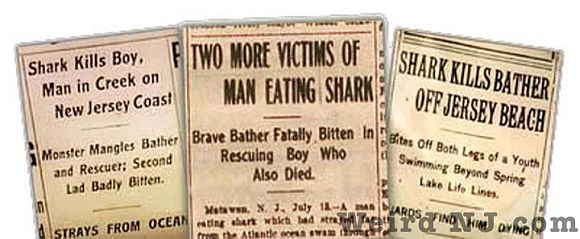
Yesterday was the start of the Discovery Channel’s ever-popular Shark Week. Along the coast of Long Island, NY and the New Jersey Shore, we are well into what could be called “Shark Month” with multiple shark sightings. Since the unofficial start of summer during Memorial Day weekend, beach officials have used drones, helicopters and beach closures to prevent a potentially deadly shark encounter after at least five people have suffered shark bites. Fortunately, none of the attacks have been life-threatening.
Given the shark activity on local beaches, it seems like a good time to look at the horrific shark attacks of one hundred and six years ago this month, when Americans, for the first time, learned to be afraid of sharks. An updated repost.
On the evening of July 1, 1916, Charles Vansant, 25, of Philadelphia was on vacation with his family at the beach-side resort town of Beach Haven on the New Jersey Shore. He decided to go for a swim before dinner. Shortly after he dove into the surf, he was attacked by a large shark and died of loss of blood.
Worse was yet to come. Five days later and 45 miles to the north in the resort town of Spring Lake, New Jersey, Charles Bruder, 27, a Swiss bell captain at a local hotel, was attacked and killed by a shark while swimming. The shark bit him in the abdomen and severed both his legs.
The next attacks came another six days later on July 12, in Mattawan Creek on Raritan Bay, 30 miles to the north of Spring Lake. 10-year-old Lester Stilwell was swimming in Matawan Creek with friends when they saw a shark’s fin in the water. The shark pulled Stilwell underwater as his friends escaped, running screaming down Main Street of the small village of Matawan. Despite the recent attacks, the townsfolk were skeptical. Matawan Creek was 11 miles from the Atlantic and no one expected a shark that far inland in the brackish water of the creek. Stilwell was also an epileptic and many thought that he had a seizure and drowned.
Watson Stanley Fisher, 24, a local young man dove into the creek and located Stilwell’s body. As he swam back to shore dragging the corpse, Fisher was attacked by the shark in front of a crowd of horrified townspeople. He was pulled from the water, but died from loss of blood. Thirty minutes later and a half-mile away, Joseph Dunn, 14, was also attacked. He was seriously injured but hauled ashore by friends and survived.
And then it was over. Before 1916, there had been no recorded shark attacks along the Jersey shore. Then suddenly, there were five attacks and four deaths over just two weeks. Many assumed that one monster shark was responsible for all the attacks, although three sharks seem more likely. In the intervening century, scientists have not even agreed on what type of shark or sharks were responsible. Most believe that one or several great white sharks were the most likely culprits. Some, however, argue that the attacks on the Matawan Creek could have been a bull shark, a species that is known to swim up rivers and creeks and can cope with brackish water better than other shark types.
The New Jersey shark attacks of 1916 were a sea-change in the public perception of sharks. As Matt McCall wrote in Smithsonian:
People knew sharks ate the flesh of other ocean creatures, but there was a dispute over whether they would—or could—bring down a human. But after the attacks in New Jersey in 1916, what were once thought to be frightening-looking yet essentially benign animals became man-eating predators. This new attitude brought us Jaws and Sharknado, and it’s seen in the response to real-life shark attacks, like those reported in North Carolina in June. But it took the New Jersey attacks nearly a century ago to remind humans just where they are on the food chain.
The 1916 Jersey Shore shark attacks are often credited as the inspiration for Peter Benchley’s blockbuster novel Jaws.
